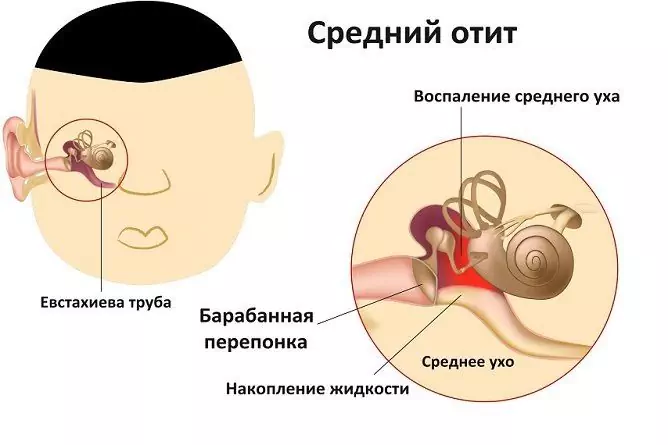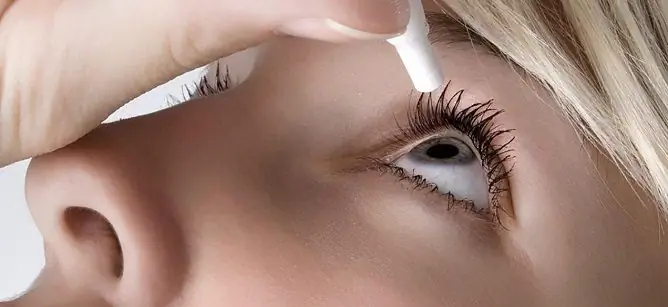- Author Rachel Wainwright [email protected].
- Public 2023-12-15 07:39.
- Last modified 2025-11-02 20:14.
Uniflox
Uniflox: instructions for use and reviews
- 1. Release form and composition
- 2. Pharmacological properties
- 3. Indications for use
- 4. Contraindications
- 5. Method of application and dosage
- 6. Side effects
- 7. Overdose
- 8. Special instructions
- 9. Application during pregnancy and lactation
- 10. Use in childhood
- 11. Drug interactions
- 12. Analogs
- 13. Terms and conditions of storage
- 14. Terms of dispensing from pharmacies
- 15. Reviews
- 16. Price in pharmacies
Latin name: Uniflox
ATX code: J01MA01
Active ingredient: ofloxacin (ofloxacin)
Producer: Unimed Pharma (Slovak Republic)
Description and photo update: 2018-21-11
Prices in pharmacies: from 122 rubles.
Buy

Uniflox is an antimicrobial agent used in ENT practice.
Release form and composition
Dosage form - eye and ear drops 0.3%: transparent solution with a yellowish tinge (5 ml each in plastic dropper bottles with a screw-on plastic stopper, equipped with a first opening control ring, in a cardboard box 1 bottle).
Composition of 5 ml solution:
- active substance: ofloxacin - 15 mg;
- auxiliary components: purified water, sodium dihydrogen phosphate dihydrate, benzalkonium chloride, sodium phosphate dodecahydrate.
Pharmacological properties
Pharmacodynamics
Ofloxacin is a fluoroquinolone, a broad-spectrum antimicrobial agent with bactericidal properties. The mechanism of action is explained by the effect of DNA gyrase on the bacterial enzyme, which ensures supercoiling and, consequently, the stability of DNA bacteria. Thus, the destabilization of DNA strands leads to their death.
The drug is active against microorganisms that produce beta-lactamases and fast-growing atypical mycobacteria. Susceptible to it: Staphylococcus aureus (including strains, Staphylococcus epidermidis), Bacillus spp., Enterococcus faecalis, Micrococcus spp., Streptococcus pyogenes, Streptococcus pneumoniae, Corynebacterium spp., Pseudomonas species, Pseudomonas species, Pseudomonas spp. Haemophilus influenzae, Neisseria gonorrhoeae, Helicobacter pylori, Acinetobacter spp., Brucella spp., Branhamella catarrhalis, Campylobacter spp., Enterobacteriaceae (Enterobacter spp., Salmonella spp., Klebsiella spp., Escherella spp., Klebsiella spp., Escher, Serratia spp.).
Ofloxacin is also active against Chlamydia pneumoniae, Chlamydia trachomatis, Mycoplasma pneumoniae and some other mycoplasmas.
Resistance to the drug is possessed by Peptococcus species, Bacteroides species, Clostridium species.
Staphylococcus aureus is 5-10% resistant to ofloxacin and 15-20% resistant to Pseudomonas aeruginosa.
Pharmacokinetics
In the lacrimal fluid, the average concentration of ofloxacin 4 hours after topical application of Uniflox is 2 μg / ml (to suppress the growth of the most common strains of pathogens of infectious eye diseases in vitro by 90%, a minimum concentration is required - MIC 90).
When the drug is instilled into the ear in the case of an intact tympanic membrane, the absorption of ofloxacin is minimal in the middle ear, however, it increases with perforations - the maximum concentration in the serum is 10 ng / ml.
After 10 days of daily use of Uniflox, the maximum serum concentration of ofloxacin is 1000 times lower than when taking similar doses of the drug inside.
Indications for use
According to the instructions, Uniflox is intended for the treatment of bacterial infections caused by microorganisms sensitive to ofloxacin:
- infections of the anterior segment of the eye in adults and children from 1 year of age: keratitis, conjunctivitis, blepharitis, keratoconjunctivitis, blepharoconjunctivitis, dacryocystitis, meibomitis (barley), corneal ulcers, chlamydial eye infections;
- otitis externa and chronic purulent otitis media, including with perforation of the tympanic membrane, in adults and children over 12 years old;
- otitis externa and acute otitis media with an installed tympanostomy tube in children 1-11 years old.
Also, the drug is used to prevent infectious complications during surgical interventions on the organs of hearing and vision in adults.
Contraindications
- diseases of the accessory apparatus of the eye, anterior and posterior segment of the eye of non-bacterial etiology;
- non-bacterial otitis media;
- children's age up to 1 year;
- hypersensitivity to drug components or other quinolone derivatives.
Instructions for use of Uniflox: method and dosage
Uniflox is applied topically.
The doctor determines the dosage and duration of therapy individually.
As eye drops, Uniflox is used for infectious eye diseases. Adults are usually prescribed 1-2 drops into the conjunctival sac of the affected eye (or both eyes) every hour for the first two days, then 1-2 drops 6-8 times a day for another 7 days, but not less than 3 days after the termination of the purulent department, in total - no more than 14 days. Children from 1 year are usually prescribed 1 drop in the eye / eye 5 times a day for 7 days. Children should be treated under the outpatient supervision of a physician.
In case of infectious diseases of the ear, adults and children from 12 years old are usually prescribed 10 drops in the affected ear 2 times a day: with otitis externa - within 10 days, with chronic purulent otitis media with chronic perforation of the tympanic membrane - within 14 days. Children 1-11 years old with otitis externa and acute otitis media with an installed tympanostomy tube are usually prescribed 5 drops in the affected ear 2 times a day for 10 days. Children should be treated under the outpatient supervision of a physician.
Features of using the drug for ear diseases:
- Before instilling Uniflox, it is necessary to warm the bottle in your hand for 1-2 minutes, since dizziness may develop when using a cold solution.
- Instillation should be carried out in a lying position on its side and kept for 5 minutes after instillation to ensure the passage of the solution through the external auditory canal. If instillation into the other ear is required, proceed in the same way.
Side effects
When using Uniflox as eye drops: itching, transient burning sensation, discomfort or pain in the eye, blurred vision, conjunctival hyperemia.
When using Uniflox as ear drops: itching, bitter taste in the mouth; very rarely - dry mouth, dizziness, ringing in the ears, ear pain, paresthesia, eczema.
Overdose
There is no information on systemic manifestations of ofloxacin in case of overdose.
After instilling an excessive dose of the drug in the eyes, rinse them abundantly with clean water at room temperature.
special instructions
With prolonged use of ofloxacin, like any other antimicrobial drug, the growth of insensitive flora is possible. If during the standard period of therapy there is no clinical improvement or the condition worsens, Uniflox should be canceled and alternative treatment should be prescribed.
When using Uniflox eye drops, patients who use contact lenses should take them off before instilling the eyes and put them on no earlier than 20 minutes later.
The solution should not be injected into the anterior chamber of the eye and under the conjunctiva.
Close the bottle tightly after each use.
Influence on the ability to drive vehicles and complex mechanisms
When using Uniflox as eye drops, the clarity of visual perception may decrease immediately after instillation, therefore, for at least 15 minutes after instillation, you should not drive a car and perform work that requires clarity of vision.
Application during pregnancy and lactation
The experience of topical application of ofloxacin during pregnancy is not enough, therefore Uniflox is prescribed only in cases where the intended benefits are higher than the possible risks.
Whether the drug penetrates into breast milk has not been established, so it is advisable to stop feeding if treatment is required during lactation.
Pediatric use
Uniflox is contraindicated in children under 1 year of age. From the age of 1 year it is used to treat infections of the anterior segment of the eye, 1-11 years old - for the treatment of otitis externa and acute otitis media with an installed tympanostomy tube, from 12 years old - for the treatment of otitis externa and chronic suppurative otitis media.
Drug interactions
Zinc, aluminum, iron and magnesium reduce the absorption of ofloxacin.
Analogs
Uniflox analogues are Dancil eye and ear drops, Ofloxacin eye ointment, Ofloxacin-SOLOpharm eye and ear drops, Floxal eye drops, Floxal eye ointment, etc.
Terms and conditions of storage
Store at temperatures up to 25 ° C, out of reach of children, in a dry place, protected from light.
Shelf life - 2 years, after the first opening of the bottle - 1 month.
Terms of dispensing from pharmacies
Dispensed by prescription.
Reviews about Uniflox
According to reviews, Uniflox is an effective topical antimicrobial drug. The disadvantages of some patients include the development of side effects and a short shelf life of drops after opening the bottle.
The price of Uniflox in pharmacies
The price for Uniflox is approximately 99-119 rubles for 1 bottle of 5 ml.
Uniflox: prices in online pharmacies
|
Drug name Price Pharmacy |
|
Uniflox 0.3% eye and ear drops 5 ml 1 pc. 122 RUB Buy |

Maria Kulkes Medical journalist About the author
Education: First Moscow State Medical University named after I. M. Sechenov, specialty "General Medicine".
Information about the drug is generalized, provided for informational purposes only and does not replace the official instructions. Self-medication is hazardous to health!






